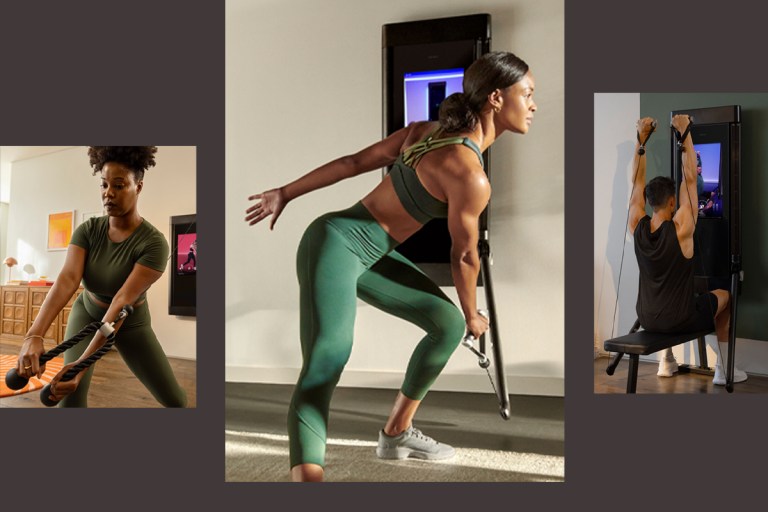Everything You Need to Know About Heavy/Light Training
Maximize gains while minimizing the amount of stress on your body and your brain.

Your chest and shoulder muscles aren’t the only body parts being challenged when you do a bench press. Your central nervous system—the neurons that receive, process, and respond to sensory information, as well as your brain and spinal cord, gets a workout, too.
The central nervous system plays a huge role in controlling muscles throughout your body, and if it’s overtaxed, you’re unlikely to see the adaptations you’re striving for. That’s where heavy/light training comes in.
What is Heavy/Light Training?
Heavy/light training, also referred to as high/low training, was started by a track coach named Charlie Francis in the 1980s and ‘90s. In running, you alternate between occasional really fast workouts in order to improve your speed and lots of slower mileage that improves your endurance; over time, the combination of the two increases your overall performance.
In the gym, heavy/light training is built around alternating days of high stress (in terms of relatively high volume, weight lifted, or another variable that triggers a physiological response) with days of low stress, so you can drive maximal gains while managing fatigue. And while the name does refer to the type of weight you’re using, “it’s more in reference to what the neurological demand of the day or movement is,” says John Christie, the director of Applied Training Science at Tonal.
“If you were to do heavy training for a week straight, that would be very demanding on your central nervous system,” adds Jacob Rauch, CSCS, PhD candidate, and performance manager of applied training science at Tonal. “So alternating between heavy/light days or even heavy/light exercise within the same workout is a great way to accumulate a lot of work without overloading your system.”
What Are the Benefits of Heavy/Light Training?
Overtraining can lead to decreased performance, excessive soreness and fatigue, difficulty sleeping, mood changes, and an increased risk for injury. Therefore, managing the amount of training stress on your body is crucial to staying on your A-game.
But this approach to training also allows you to target different adaptations simultaneously—whether that’s within a week or a single workout, says Rauch.
Generally, your muscles need up to 48 hours to recover from a hard workout. Alternating more demanding workouts with less demanding workouts over the course of a week allows you to optimize the higher-intensity workouts while promoting active recovery.
Within a strength training session, you can also use this approach to develop multiple physical qualities at the same time.

“A higher-load set is going to have greater mechanical tension,” explains Rauch. Mechanical tension is the force created by a muscular contraction against resistance, and it’s what drives hypertrophy, or the increase in muscle size. But “during your lower-load sets, you’re going to be able to do more repetitions and train closer to failure,” he says, increasing your muscular endurance and stamina. Both sets force your body to activate more high-threshold motor units, which increases your potential to build bigger muscles.
Combining the two approaches in a single workout—by coupling a heavier compound exercise with a lighter lift that acts almost like accessory work—also allows you better train movement patterns, so you’re getting a higher quality session and dialing in that neuromuscular connection, says Christie. That can help you develop more overall muscle strength and power.
How Do You Structure a Week of Heavy/Light Training?
The current Physical Activity Guidelines for Americans recommend at least two days per week of muscle-strengthening activity. If you’re only doing two strength training days per week, consider doing one heavy day and one light day.
But, if you prefer strength training four days a week, for example, your schedule would look something like this:
“Monday would be a heavy day, Tuesday could be a lighter day, Wednesday could be a full-on recovery day, Thursday another heavy day, and then Friday another light day,” says Christie. “It’s all about alternating.”
On those heavy days, you would prioritize activities such as sprints, plyometrics, lifting heavy weights, and maximal conditioning—putting your central nervous system under a lot of stress. On the light days, you’d stick to things low- to moderate-intensity aerobic efforts, agility and mobility work, and lifting lighter weights—all of which promote fitness gains without further taxing your system.
What’s an Example of a Heavy/Light Workout?
While the traditional heavy/light or high/low approach was spread out over the course of a week, you can apply it to a single strength training session. Lifting heavy and light loads within the same workout was found to improve strength in a 2018 review published in the journal Sports Medicine.
“Alternating between heavy/light days or even heavy/light exercise within the same workout is a great way to accumulate a lot of work without overloading your system.”
– Jacob Rauch, CSCS, PhD candidate, and performance manager of applied training science at Tonal
In that case, “you’d start off with a neurally demanding movement, like a compound exercise that engages multiple muscles and joints, at a higher percentage of your one-rep max,” says Christie. “You’d follow that with something that is almost like an accessory to the compound lift, with more reps but at a lower intensity overall.”
The idea is that you’re producing a lot of force to get through that heavy resistance, and then carrying that over into a lower-intensity effort to really work on your technique and form. That lighter effort also acts as active recovery, so you’ll be ready to perform at 100 percent in your next set.
Heavy/Light Training on Tonal
You can incorporate heavy/light training on Tonal by filling your week with a mix of heavy-lifting workouts and lower-weight deload sessions. Or try one of these programs or workouts that combine the two:
20-in-20: Max Muscle Splits – Multiple Coaches

You’ll focus on one muscle group each day in this program’s workouts and use heavy/light loading to maximize both strength and hypertrophy benefits.
Built for Strength with Joe Rodonis

Built for Strength with Tanysha Renee

These muscle-building lower- and upper-body workouts pair heavy compound lifts with accessory exercises and bodyweight moves. These serve as active recovery to balance out the high-volume work and give you a chance to challenge smaller muscles.


